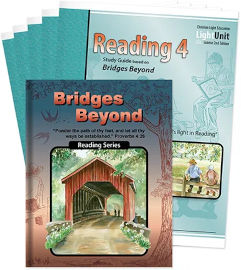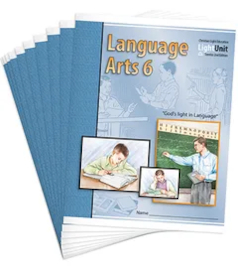Christian Light Education offers complete language arts courses for grades one through twelve. This review focuses on the courses for grades three through eight. You can read my review of the first- and second-grade courses here.
These courses are part of Christian Light's Sunrise curriculum, and the reading and language arts courses are now in their second editions. These editions teach in a spiral fashion, presenting small increments of new instruction along with continual review. About 30% of a lesson exercise is new material, while 70% is review.
Rather than textbooks, students have a set of five to ten LightUnit workbooks for each course. The consumable LightUnit booklets are printed with only two or three colors. They each include two quizzes and a test that should be removed until time to use them.
All Sunrise courses have one or two Teacher's Guides featuring reduced images of student pages from LightUnits with overprinted answers. Additional instructions and information for the teacher surround the student pages. Several appendices at the back of each Teacher’s Guide have resources such as alternate tests, indices, scope and sequence, and glossaries. The Teacher’s Guides are all large, spiral-bound books that are surprisingly inexpensive for their size.
All these courses were designed to require minimal preparation by the classroom teacher or homeschool parent.
While the reading and language courses for these grades can be used independently, they are designed to be complementary.
Reading Courses
 The reading courses each have five LightUnits, except Reading 3, which has 10. While Reading 3 will take the entire school year, the others require about half that time. The shorter courses do not correlate with the language courses, so you can complete one in a semester or spread it out over the entire year with reading classes fewer days per week.
The reading courses each have five LightUnits, except Reading 3, which has 10. While Reading 3 will take the entire school year, the others require about half that time. The shorter courses do not correlate with the language courses, so you can complete one in a semester or spread it out over the entire year with reading classes fewer days per week.
Reading courses teach reading skills (e.g., phonics, comprehension, making inferences, predicting outcomes, and analyzing stories and poems) and vocabulary. The upper grades shift into serious literary analysis and often add notes for the teacher to share context about real places or settings of stories. Stories in the readers gradually get lengthier, but students do not read complete novels.
Most lessons present a few vocabulary words for students to learn, and workbook exercises reinforce that learning. Older students learn some Latin word roots and prefixes.
The hardcover reader for each course has some full-color illustrations and glossaries of new words at the back. Reading courses teach reading skills through LightUnit workbook pages and discussion questions in the Teacher’s Guides. Students are expected to read aloud (even through eighth grade) and participate in discussions, so a parent or teacher needs to work with them some of the time.
Most stories begin with a Bible verse, and students read, recite, and review the Bible verse for each story several times, including at least once on workbook pages.
As with other Christian Light courses, things of God receive a great deal of attention. The warm and gentle stories and poems in the readers generally start with a Scripture verse and teach lessons about thankfulness, honesty, unselfishness, and other godly attitudes and character traits. A few stories that take place in other lands and cultures are included but no fairy tales. Illustrations reflect Mennonite culture and values with modestly clothed figures (men and boys in long pants, women and girls in dresses) and subject matter referring to rural life.
Language Arts Courses
 Language arts courses each have 10 LightUnits that teach grammar, usage, sentence diagrams, composition, handwriting, and other skills, such as alphabetizing and using reference works. In addition to alternate tests, indices, and the course’s scope and sequence, the appendices of the language arts Teacher’s Guides also have lists of spelling words, spelling tests with sentences, and a list of poems included within the course’s LightUnits. Other appendices vary by grade level and might include phonics rules, grammar reference charts, lists of penmanship copywork, and handwriting models.
Language arts courses each have 10 LightUnits that teach grammar, usage, sentence diagrams, composition, handwriting, and other skills, such as alphabetizing and using reference works. In addition to alternate tests, indices, and the course’s scope and sequence, the appendices of the language arts Teacher’s Guides also have lists of spelling words, spelling tests with sentences, and a list of poems included within the course’s LightUnits. Other appendices vary by grade level and might include phonics rules, grammar reference charts, lists of penmanship copywork, and handwriting models.
Composition
While students do both creative and expository writing at all grade levels, those in grades three through six write reports, while seventh and eighth graders write research papers with bibliographies. Students learn structured processes for both creative and expository writing, and they learn to edit their own work.
The instruction on research papers relies primarily on using books and print resources. They mention using the internet but with a strong caution about the unreliability of many sources. Students are instructed to create individual bibliography cards rather than a file of entries on a computer. I acknowledge that cards provide a physical tool for organizing material, but it is now easy to organize notes on a word processor. The principles remain the same, but most students today rely on the internet for at least part of their research and most of their writing, and parents might want to address how students can collect, record, and organize their work for research papers on a word processor.
The ninth LightUnit in each language arts course focuses on poetry. Those units include several poems to teach appreciation as well as poetic elements. Students apply what they learn as they write at least one poem of their own.
Grammar
Grammar instruction gradually teaches the parts of speech and sentence diagramming: Language Arts 3 teaches nouns, verbs, and adjectives; Language Arts 4 adds adverbs and conjunctions; and so on through eighth grade where students encounter very complex sentences with all eight parts of speech and the various roles they play in the construction of sentences.
Spelling
For grades three and four, students are given a list of 15 words to learn for every four lessons; they have three such lists per LightUnit. Rather than testing on all of the words, quizzes assess mastery of 10 words, and tests assess 20 words. Students cut out bookmarks with their word lists from the back of each LightUnit and insert them in the booklet as they progress to keep them handy for study. Grades five through eight teach 20 new words for every four lessons and include 30 on tests.
Penmanship
Cursive handwriting is taught in third grade and continues through eighth grade. For grades three and four, students are provided with sentences written in cursive to copy into a separate notebook. For fifth grade and above, students are given sentences within the lessons (in typeface) to copy in cursive into their notebooks.
Summary
Christian Light Reading and Language Arts courses appeal to Christian families who appreciate the values and worldview that permeate the courses. The courses also work well for busy parents who prefer a combination of direct instruction and independent work. The courses make it easy for parents to check student work and continually assess their progress.









